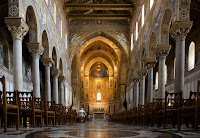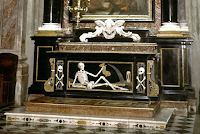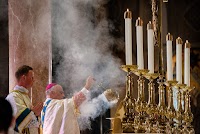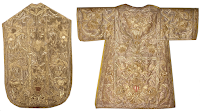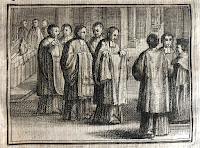 The Stavelot Triptych is the earliest surviving triptych style reliquary of the True Cross with illustrations from the Legend of the True Cross and is unique in that it unites in a single work of art Eastern and Western (Byzantine and European) iconographic and craftsmanshi…
The Stavelot Triptych is the earliest surviving triptych style reliquary of the True Cross with illustrations from the Legend of the True Cross and is unique in that it unites in a single work of art Eastern and Western (Byzantine and European) iconographic and craftsmanshi…
Our Advertising Partners
-
The global pandemic has disrupted the normal celebration of the Holy Week in Spain, where, for a second year, the government has forbidden t...
-
We live in a very visual, image-based culture and, what's more, there is always lots of curiosity around the matter of traditional papal...
-
Above is an image of Pope John XXIII after his death in 1963, dressed in red vestments for burial (the arms on the front of the chasuble app...
-
The mitre is one of the most recognizable symbols of prelates of the Church, specifically of bishops up to the Roman pontiff himself -- thou...
-
The papal blessing known as the Benedictio Coram Populo, or more commonly as the Urbi et Orbi (to the city [of Rome] and to the world) bless...
-
To the person who simply enjoys beautiful art and architecture, distinctions like "baroque" or "rococo" might seem overl...
Blog Archive
-
▼
2021
(258)
-
▼
July
(22)
- The Stavelot Reliquary in New York
- Reprint: Proposal for the Internal Design and Layo...
- A Newly Embroidered Conopaeum (Umbraculum) by Lawr...
- Three European Woodcarvers
- The Lutrin (or Lectern)
- Sacristy Tips: "Every Jot and Tittle" (Or On the C...
- Two Contemporary Hand Illuminated Liturgical Books...
- Two Embroidered Mitres by the Poor Clares of Mazam...
- Further Embroidery of the Poor Clares of Mazamet, ...
- Other Modern Work of the Poor Clares of Mazamet, F...
- The Metropolitan Cathedral of Monreale, Sicily
- An Altar of the Dead from 1695
- Some Italian Antependia from the Seventeenth and E...
- St. François de Laval and the Grand Séminaire of Q...
- The Golden Chamber of St. Ursula's Basilica in Col...
- A Brief Consideration On the Diverse Shapes of Cha...
- Summorum Pontificum and the Flourishing of the Lit...
- Tela Aurea: A Cloth of Gold Set from the First Hal...
- St. John Henry (Cardinal) Newman on Ecclesiastical...
- Sixteenth Century Spanish Vestments from Granada C...
- The Ceremonial Vesting of a Prelate in East and West
- Floriated French Vestments of the Seventeenth Century
-
▼
July
(22)
Donate
Copyright ©
Liturgical Arts Journal | Powered by Blogger





















